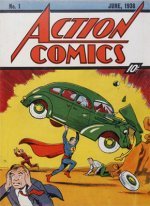Undervalued Comics: Batman 100
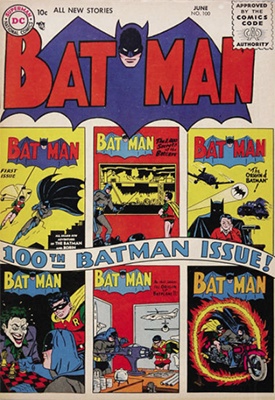 Undervalued Comics: Batman 100. Click to find a copy
Undervalued Comics: Batman 100. Click to find a copy
Happy Anniversary, Batman 100, You’re an Undervalued Comic
Batman was not the first comic book title to reach 100 issues. Not by a long shot. In fact, by our count, it was at least the 57th series to pass that notable milestone.
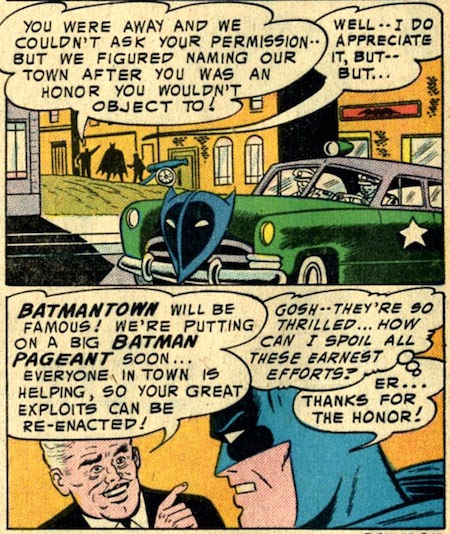 Batman #100: Batmantown! Gotham City will never be the same again...
Batman #100: Batmantown! Gotham City will never be the same again...Although, to be fair, many of first 56 comic books to hit the celebrated century mark did so only by playing fast and loose with postal permit regulations, continuing numbering from one book to another, completely unrelated title, often more than once.
And it should also be observed that in the waning days of the Golden Age, when comic circulation was falling and anti-comic sentiment rising, several of the earliest series got the ax soon after reaching their 100th issue.
So, while less than a dozen titles were in triple digits when, on April 19, 1956, Batman #100 came along, the event itself was not a particular rarity. Cowboys Gene Autry and Roy Rogers, aviators Blackhawk and Airboy, and even cartoon combatants Tom and Jerry, all got to #100 before Batman.
So, what makes Batman #100 a special case? What qualities translate into in being an undervalued comic?
It’s the usual suspects — supply, demand, and historical significance.
Let’s look at the latter first.
In that interregnum between the Golden and Silver Ages, nobody trumpeted an anniversary issue. For one thing, publishers of the era supposed they were hawking disposable joy. It never occurred to them they were, in fact, marketing collectibles.
And why would it? Kids of that era were no more expected to save their comic books than their parents were expected to preserve for all posterity the daily newspaper.
But one thing the delinquency scare of the early 1950s did was to wake publishers up to the collectable nature of their product. After all, parents were not exactly cleaning out local newsstands to conduct comic book bonfires in the town square.
No, their fuel of choice was whatever comics their kids had on hand. And to judge by the size of bonfires seen in extant news photos, their kids had been hoarding comic books by the shovelful.
You see, kid brains are not wired like adult brains. It simply never occurred to most younglings that they should read a comic book just the once, and then toss it in the trash.
So, while anniversary issues had hitherto passed by unheralded, by the time Batman #100 — and shortly before it, Superman #100 — came along, the DC bean counters had caught the sweet whiff of money off the winds of change.
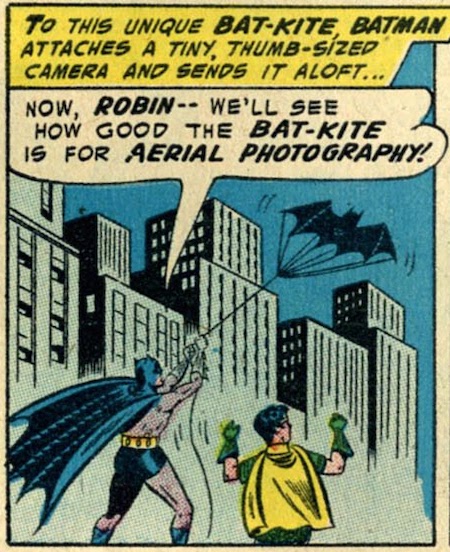 Batman #100: Origin and First Appearance of the Bat-Kite!
Batman #100: Origin and First Appearance of the Bat-Kite!Sure, circulations were falling overall, but there was a way, they saw, to goose the trend. All they had to do was convince the kids who saved their comics that an anniversary issue could not to be missed.
Thus the giant banner across the front cover of Batman #100, proclaiming it to be the “100th Batman issue!”
It was like a carnival barker calling out to the kids who, on their weekly sojourn to the corner newsstand, stood mouths agape at the four color splendor spread out before them, just waiting for the dimes to be sucked out of their darling pockets.
“Hey, Kids!” The barker shouted. “You have lots of Batman comics. You know Batman is cool. But this is a special issue of Batman! How cool is that?!!”
Of course, like everything else, marketing evolves in fits and starts. No comic book publisher, not even DC, had yet gleaned the sales potential of an “event” issue. That being the case, Batman #100 was not a triple-sized book with glossy pages, a cardstock shell, and 47 variant covers, promising, “After this, EVERYTHING changes!!”
No, in point of fact, apart from its cover, Batman #100 was just another issue of Batman, completely typical of its era. But as long as we’re here and talking about it, let’s have a look inside:
Batman #100 sported, as per usual, three tightly-plotted tales — one written by Batman co-creator Bill Finger, the other two of uncertain authorship, with all three drawn by Sheldon Moldoff and inked by Charles Paris under the check-cashing signature of Bob Kane.
The Finger story, for what it’s worth, features the first appearance of the Bat-Kite. But don’t get excited. This was not an uber-cool, Kite-Man-style full-body hang glider. Bat-Kite v.1 was an actual kite, it being the winning entry in a contest Batman held to choose the best new crime-fighting invention.
This means that, yes, in this issue — brace yourself for it — Batman flies a kite.
The other two stories might as well be filed under ‘U’ for Unlikely.
In one, the town of Plainville unwittingly attracts a criminal element when town fathers, hoping to lure tourists, changed the the name of their bucolic suburb to Batmantown. You’d think criminals would be falling over themselves to avoid a place called BATMANtown, but whatever.
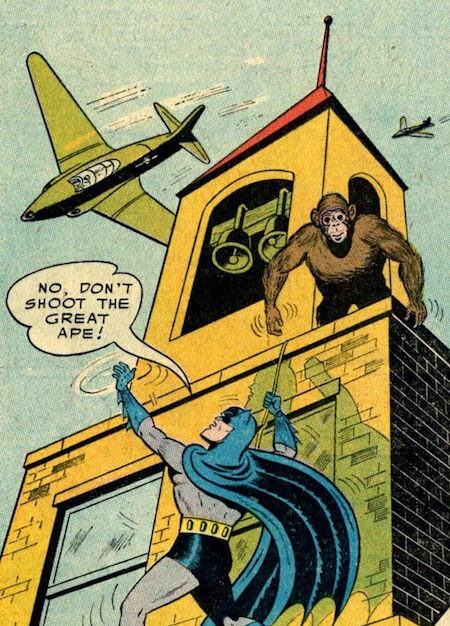 Batman #100: Monkey smuggles jewels...
Batman #100: Monkey smuggles jewels...In the third story, Batman and Robin have to round up escaped zoo animals down at the Gotham docks, only to learn the menagerie was set free on purposed because one of them — a giant ape named Pongo — is being used to smuggle jewels.
Now, if you’ve watched a lot of crime docudramas, you might be excused for thinking, “Oh, my God! They stuffed jewels up the monkey’s butt!” But no, Freaky, the diamonds were in its collar.
Even so, you’d think there’d be an easier way to get hot ice past customs.
Now, at this point, you may well be saying to yourself, oaky, Bat-Cover, Bat-Kite, Bat-Town, all fine and well, but what is it about Batman #100 that makes it historically significant?
It’s the cover.
And not because of the 100th-issue banner. It’s because, among the six old Batman issues it shows off, is Batman #1.
This is, as far as we can tell, and to the extent the Grand Comics Database identifies such things, the very first reprinting of that iconic cover. It’s the first re-presentation of all six covers, actually, but it’s #1 that matters.
But, why? Today, with resources like the GCD and reprints aplenty, seeing Batman #1 doesn’t exactly set nerve ends a-tingle. But imagine, to the young readers of 1956, this would have been heady stuff, indeed.
After all, there were no price guides back then, no archival editions, no internet databases. Heck, no internet at all. Even organized fandom was still at least a half-decade away.
Meaning no clubs, no fanzines, no mailing lists, and no way, even, to sneak a peak at older books some fellow fan might have been lucky enough to score off a father or grandfather, which would have been the only real recourse back when — because, horrors upon horrors — among the many things people had not yet been smart enough to invent ... no comic book stores!
In other words, when Batman #100 came out, that would’ve been the very first time virtually anyone then buying new comic books would have seen Issue #1. Until that moment, they wouldn’t haver had only the vaguest idea such a mythical beast even existed, let alone what a 16-year-old treasure like it might actually look like.
So, yeah, having the first known reprint of the cover to Batman #1 is historically significant, if only because it was an early cog in the machine publishers built to indoctrinate kids into the world of collecting. Batman #100 was among the first comics to actively market a world of comics beyond what was currently on sale.
nd it was a world, Batman #100 suggested, that needed to be explored, because it existed with wonders overflowing long before whatever comics any one kid might have stored in a shoebox — or, at least had until that box got raided by pyromanic parents.
Batman #100 is important because it, and books like it, established interest in back issues, and by so doing, basically built the back issue market.
Or it could be the Bat-Kite. Collectors are weird, you never know what’ll get them off.
Guide to Batman 100 Comic Book Values
But importance isn’t the only criteria for investment potential. Scarcity plays a role — and in the case of Batman #100, a significant role.
Consider, as we’ve noted, 1956 was still pre-history in terms of organized fandom. Yes, kids were evolving into collectors, buying certain issues for reasons other than just because it’s what happened to be on the stands that day, and hanging on to them not just because they didn’t know enough to throw them out. But even so, while they were fans, few were as yet truly fanatic. Comic books were a long way still from coming off the shelf and going unread straight into an archival bag, to be shipped off to the slab factory.
Oh, come to think of it, that’s another thing that didn’t exist yet: Bags and boards.
Anyway, at least partly because of this pre-bag status, the CGC Census currently records just 304 Universal certified copies of Baton #100. And of those, a mere 10 are graded 8.5 or better.
In other words, there just are not many of this book out there. And a high-grade copy is a rare unicorn indeed.
But what is scarcity without demand? Is Batman #100 in demand?
We can access that from recent sales action.
A CGC 9.2 sold in September 2022 for $12,600. That’s a nice stair-step from the 9.0 that sold in January 2021 for $8,400 and the 8.5 that went in September 2019 for $4,000. As an outlier, the one 9.4 known to exist last sold in March 2020 for $18,250.
Meanwhile, and perhaps more importantly, a lowly 1.5 went in February 2021 for $350. That’s 2.7 percent of the hammer price on the 9.2, which falls squarely within the 2-to-5 percent margin on a Near Mint we would normally expect to see for a 2.0 copy.
This shows that the high and low ends are moving more-or-less in concert, as we would expect when a book starts to gain market traction.
As we’ve mentioned in other articles within this “Undervalued Comics” series, top- and low-end sales both tend to be vanity purchases. At the high end, buyers want the best possible example of a given book, either for bragging rights, or for investment potential. Often both. At the bottom end, collectors with less money are just keen to say they own a particular book, whatever the grade. Thus, driven by emotion as much as anything else, the ends advance first, then drag the middle along to a new mean.
And speaking of the middle, it is at the mid-grades where Batman #100 is showing other tells of a book about to pop, like when lower grades outperform previous sales of higher grades.
For example, recent sales of a 5.0 for $1,200 and a 4.5 for $950 more than eclipsed 2019 sales of a 6.0 at $941 and a 5.5 for $730.
And eyeball that 6.0 if you will. Normally, we’d expect a book certified Fine to sell for about 15 percent of the going price on a Near Mint. But the recent 9.2 went at a price that pushes that last 6.0 sale down to just 7.5 percent.
This means we’d expect the next 6.0 trade to double the 2019 take in that grade, coming in at, or close to, $1,800. Or, if not the next sale, one soon after, as savvy sellers analyze their GP Analysis, as we’re doing here, and reset their price tags.
Anyway, here’s the current value spread on this book, followed by our recommendations:
- CGC 9.4 — $18,250
- CGC 9.2 — $12,600
- CGC 9.0 — $8,400
- CGC 8.5 — $4,000 (Sep. 2019)
- CGC 8.0 — $2,351 (Dec. 2015)
- CGC 7.5 — $2,880
- CGC 7.0 — $1,920
- CGC 6.5 — $1,320
- CGC 6.0 — $941 (Jul. 2019)
- CGC 5.5 — $730 (Oct. 2019)
- CGC 5.0 — $1,200
- CGC 4.5 — $950
- CGC 4.0 — $587
- CGC 3.5 — $540
- CGC 3.0 — $525
- CGC 2.5 — $506
- CGC 2.0 — $306
- CGC 1.5 — $350
- CGC 1.0 — $200
- CGC 0.5 — $195 (Apr. 2020)
If you have Batman #100 raw in any grade, it’s worth sending it in for certification and getting it on the market as soon as you possibly can.
At the very high and very low CGC grades, it’s a good time to sell, especially if you’ve been holding on to this book for a while. Time to pocket those gains.
However, Batman #100 could be starting to plateau at the extreme ends of the market, where it recently recorded new highs. If you’re buying high and/or low grades with the hope of realizing large percentage gains, go ahead, but you’ll probably need to vault this one for a few years to await the next value step.
But in the middle grades — anywhere from 2.0 to 8.5 — it’s a GREAT time to set your prices in line with recent high sales, and offer it up to market.
It’s also a great time to BUY the mid-grades, especially if you can land a deal anywhere close to the prices listed above. But do it quick before too many others realize what’s happening and start selling off their mid-grade copies.
Because once the middle starts to better align to the ends, this book should find its level pretty quickly, and we’d expect to see it settle there for a couple of years before the next record high sale kicks off a new round of value hikes.
Have this book? Click to appraise its value or Consign Yours for Auction!
INDEX OF UNDERVALUED COMIC BOOKS
Related Pages on Sell My Comic Books
Other DC Comic Superheroes in Batman 100





